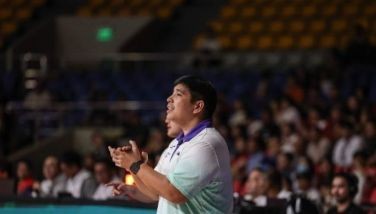Mestizo rice to make RP self sufficient by 2004 — Lorenzo
May 11, 2002 | 12:00am
Presidential Adviser Luis P. Lorenzo Jr. said yesterday a big demand awaits hybrid rice seeds produced by the Philippines and other world suppliers.
Lorenzo presided over the launching yesterday of the mestizo hybrid rice seeds being propagated by the Philippine Rice Research Institute, of which he is the chairman. Lorenzo said he received-inquiries for hybrid rice supplies from Malaysia when he went there with the President this week.
Lorenzo said Malaysia needs $10-million worth of rice hybrid seeds for commercial cultivation, which its farmers can not seem to perfectly grow because of the intricacies of breeding superior strains of male and female needs. Not to mention, he said, that seed production requires a lot of field manpower and other inputs.
He projects that given the intensity and keen interest of rice farmers to go into hybrid rice seed production, "we will attain sufficiency in these seeds by 2004 which will enable us to become net exporter of rice seeds to our Asian neighbors."
He reported that in his conversations with some farmers and agriculture officials in Kuala Lumpur, problems like diminishing farm labor population (with farm youths preferring to migrate to urban centers) and their hunger for applied technologies cropped up indicating that the Philippines shares its problems with its neighbors in Asia. Also there is a growing urgency among Asian neighbors to improve their competitiveness to be able to hurdle the challenges posed by globalization.
Lorenzo said it would be wiser for the government to let the National Food Authority buy hybrid seeds produced by local farmers instead of importing rice.
Philrice launched its hybrid rice seeds for commercial propagation this May 15 until July 15 in some 45,000 to 50,000 hectares of selected farms in the country. Seventy-five percent of these farms are in Mindanao while the rest are in Luzon. This crop will be harvested in September-October.
After this first batch of hybrid rice seeds, Philrice will again propagate this high yielding parental strain in 85,000 to 100,000 hectares by November in farms distributed throughout the country.
The first batch of hybrid rice seeds planted by Philrice-trained farmers in Mindanao and Isabela showed tremendous improvements in their yields and income.
Lorenzo reported that farmers who participated in the seed production program were able to increase their earnings from P10,000 to P15,000 per hectare per cropping using traditional varieties to P35,000 to P43,000 per hectare with the hybrid line.
Lorenzo, who is also presidential adviser for jobs creation, said the hybrid variety will enable the country to become self sufficient in rice by 2004. At the same time, it will generate thousands of jobs in the rural areas because a hectare of farm planted to hybrid rice seeds production requires three to seven people.
Farmer Romeo Vasquez, who planted hybrid rice seeds in San Mateo, Isabela, said he used to harvest 18 cavans less than one tone using certified seeds but when he planted hybrid seeds he was able to produce nine tons per hectare. Furthermore, the hybrid variety is resistant to tungro (a disease in rice) and is sturdy enough to avoid lodging during the rainy season.
Philrice executive director Leocadio Sebastian said the agency has not yet come up with research on growing hybrid rice seeds in upland or rainfed farming areas since it is yet in the process of perfecting the mestizo strain in irrigated farms.
Lorenzo presided over the launching yesterday of the mestizo hybrid rice seeds being propagated by the Philippine Rice Research Institute, of which he is the chairman. Lorenzo said he received-inquiries for hybrid rice supplies from Malaysia when he went there with the President this week.
Lorenzo said Malaysia needs $10-million worth of rice hybrid seeds for commercial cultivation, which its farmers can not seem to perfectly grow because of the intricacies of breeding superior strains of male and female needs. Not to mention, he said, that seed production requires a lot of field manpower and other inputs.
He projects that given the intensity and keen interest of rice farmers to go into hybrid rice seed production, "we will attain sufficiency in these seeds by 2004 which will enable us to become net exporter of rice seeds to our Asian neighbors."
He reported that in his conversations with some farmers and agriculture officials in Kuala Lumpur, problems like diminishing farm labor population (with farm youths preferring to migrate to urban centers) and their hunger for applied technologies cropped up indicating that the Philippines shares its problems with its neighbors in Asia. Also there is a growing urgency among Asian neighbors to improve their competitiveness to be able to hurdle the challenges posed by globalization.
Lorenzo said it would be wiser for the government to let the National Food Authority buy hybrid seeds produced by local farmers instead of importing rice.
Philrice launched its hybrid rice seeds for commercial propagation this May 15 until July 15 in some 45,000 to 50,000 hectares of selected farms in the country. Seventy-five percent of these farms are in Mindanao while the rest are in Luzon. This crop will be harvested in September-October.
After this first batch of hybrid rice seeds, Philrice will again propagate this high yielding parental strain in 85,000 to 100,000 hectares by November in farms distributed throughout the country.
The first batch of hybrid rice seeds planted by Philrice-trained farmers in Mindanao and Isabela showed tremendous improvements in their yields and income.
Lorenzo reported that farmers who participated in the seed production program were able to increase their earnings from P10,000 to P15,000 per hectare per cropping using traditional varieties to P35,000 to P43,000 per hectare with the hybrid line.
Lorenzo, who is also presidential adviser for jobs creation, said the hybrid variety will enable the country to become self sufficient in rice by 2004. At the same time, it will generate thousands of jobs in the rural areas because a hectare of farm planted to hybrid rice seeds production requires three to seven people.
Farmer Romeo Vasquez, who planted hybrid rice seeds in San Mateo, Isabela, said he used to harvest 18 cavans less than one tone using certified seeds but when he planted hybrid seeds he was able to produce nine tons per hectare. Furthermore, the hybrid variety is resistant to tungro (a disease in rice) and is sturdy enough to avoid lodging during the rainy season.
Philrice executive director Leocadio Sebastian said the agency has not yet come up with research on growing hybrid rice seeds in upland or rainfed farming areas since it is yet in the process of perfecting the mestizo strain in irrigated farms.
BrandSpace Articles
<
>
- Latest
- Trending
Trending
Latest
Trending
Latest
Recommended






























